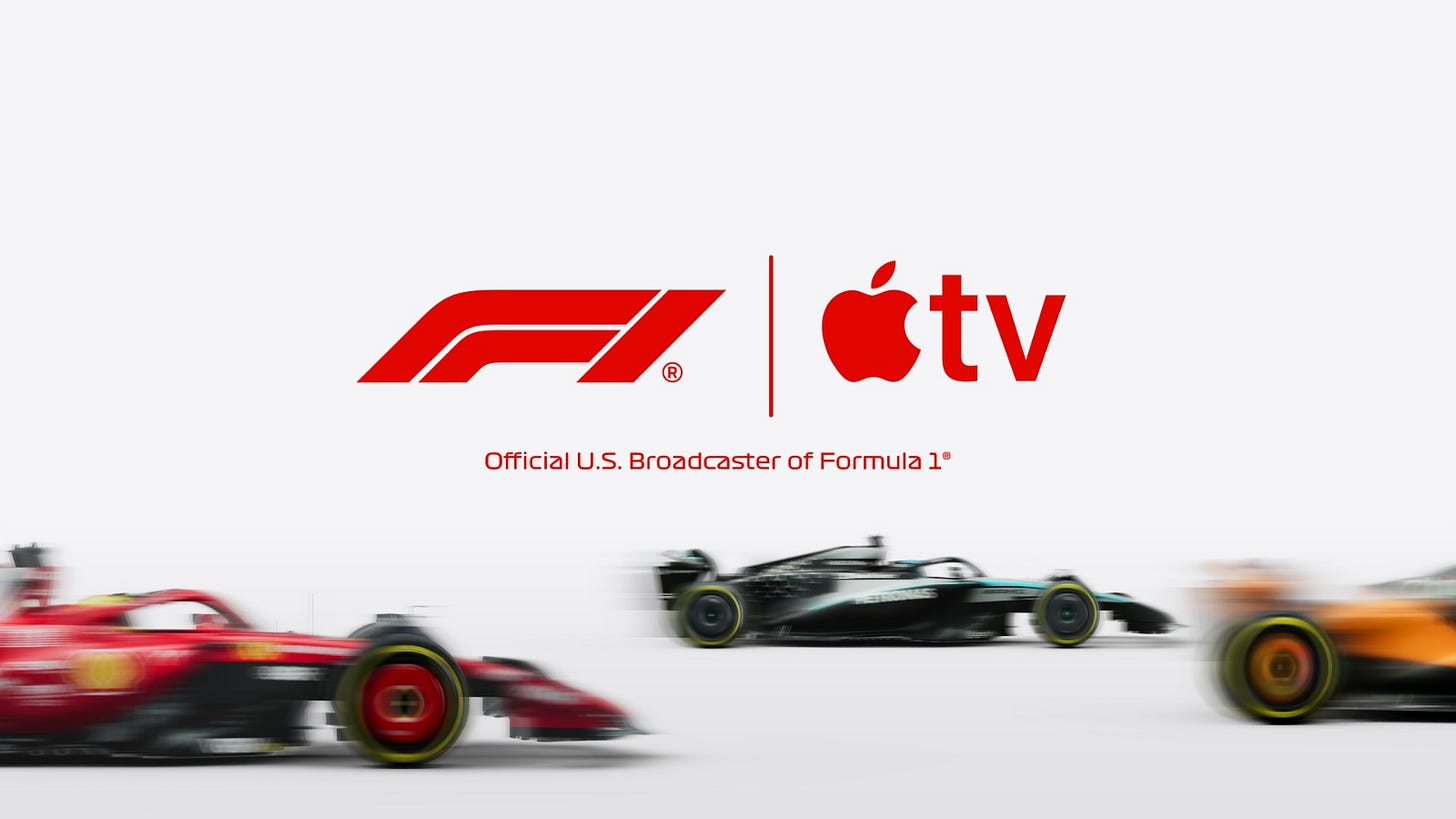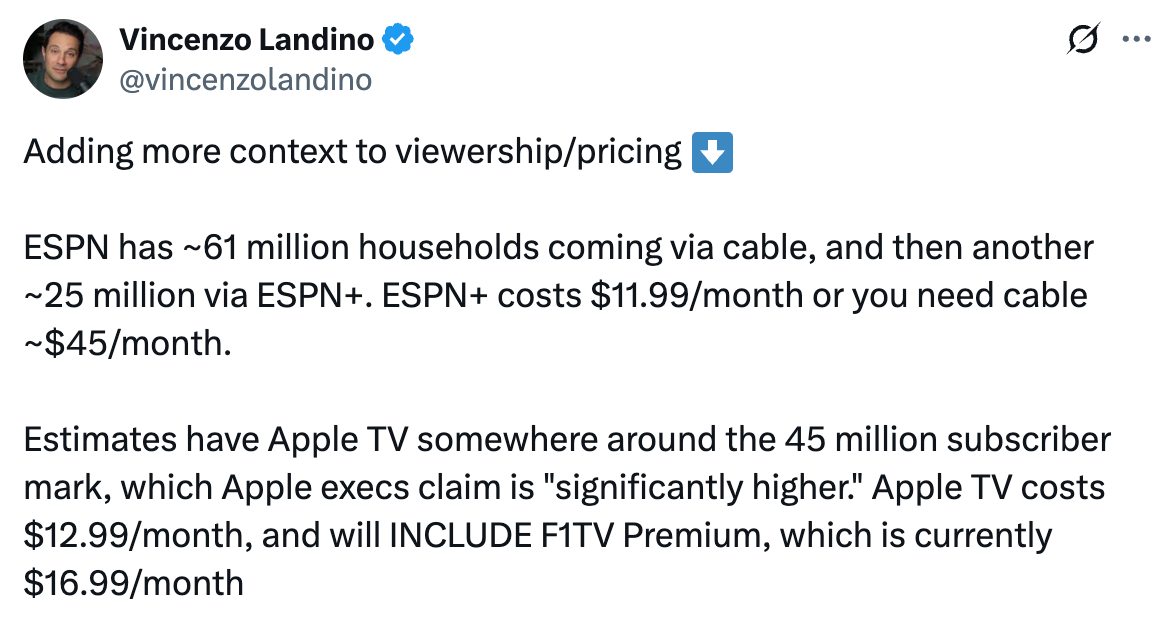Apple’s $750M Bet on Formula 1 is About Ecosystem Dominance
The movie was the proof of concept. The broadcast deal is the product launch.
Today, Formula 1 and Apple finalized a five-year deal that hands Apple TV exclusive U.S. broadcast rights starting in 2026. Apple is paying approximately $140-150 million annually—nearly double ESPN’s $85-90 million—bringing the total deal value to roughly $750 million through 2031.
This is a calculated move to turn F1 into the connective tissue across Apple’s entire product ecosystem.
The Movie That Made the Deal
The relationship between Apple and F1 didn’t start with a handshake in Austin; it began three years ago on a film set.
F1: The Movie, starring Brad Pitt, has grossed $629 million worldwide, making it the highest-grossing sports film in history and Brad Pitt’s most successful feature to date. It’s also 2025’s highest-grossing original film.
That success wasn’t luck. Apple built a custom camera system, essentially a stripped-down iPhone 15 Pro sensor wrapped in an FIA-compliant package that could withstand 220 mph and 5G cornering forces while shooting ProRes Log footage. The exact thermal handling, LOG video support, and color workflows Apple developed for the film now live inside consumer iPhones.
F1 CEO Stefano Domenicali confirmed they’ve been “working together for the past three years” on the film, and that relationship has served as the foundation for broadcast negotiations. When Apple walked into those Sun Valley meetings at the Allen & Co. Conference in July, they pitched a proven partnership.
What You’re Actually Getting
Starting in 2026, every F1 practice session, qualifying round, Sprint, and Grand Prix streams on Apple TV for $12.99 per month—no add-ons, no tiers. Unlike Apple’s MLS deal, which requires a separate Season Pass, F1 is baked directly into the standard subscription.
Here’s the kicker: F1 TV Premium, usually $16.99/month, gets folded into that $12.99 Apple TV subscription at no extra cost. You’re getting more content for less money than the standalone services combined.
Select races and all practice sessions will be free in the Apple TV app throughout the season. Broadcasts will offer both English and Spanish feeds, targeting the 40+ million Spanish speakers in the U.S.
Beyond the Screen
This is where Apple’s strategy sharply diverges from that of traditional broadcasters. ESPN treats F1 as programming. Apple treats it as infrastructure for cross-device engagement.
The free Apple Sports app will deliver live leaderboards, real-time standings, Live Activities on iPhone lock screens, and dedicated home screen widgets for every qualifying, Sprint, and race. Apple News, Apple Maps, Apple Music, and Apple Fitness+ will all amplify F1 content year-round. Apple Stores will feature F1 promotions.
Eddy Cue, Apple’s SVP of Services, made this explicit: “We’re going to bring everything Apple has to offer, from our retail stores to all of our apps...We have so many touch points with our customers”.
F1 becomes a showcase for interactivity, immersion, and cross-device integration. It’s the same playbook Apple used with MLS—though MLS largely disappeared from casual sports conversation after moving behind a paywall. The difference here is that F1 already has momentum.
The Revenue vs. Reach Gamble
ESPN didn’t walk away because it couldn’t afford F1. They walked away because the math didn’t pencil. Disney chose distribution reach over premium pricing. Apple is betting that exclusive, premium content can overcome a massive distribution disadvantage.
Consider: Apple TV reaches only 11% of U.S. households. ESPN is in virtually every cable and streaming home in America. Yet Apple is willing to pay a 55% premium over ESPN’s deal because it’s not just buying content.
Apple sees this as a technology showcase and a user-acquisition tool.
F1 viewership on ESPN averaged 1.4 million viewers through September 2025, the highest ever for a U.S. season. The Azerbaijan Grand Prix in September hit 1.1 million viewers, a U.S. record for that race. Full-season viewership is up from 1.22 million at the same stage last year.
But there’s a ceiling. The Miami Grand Prix, arguably F1’s most favorable U.S. TV window, dropped 29% year-over-year to 2.17 million viewers in 2025. NASCAR’s Texas race, airing opposite Miami on FS1, pulled 2.56 million. F1 is growing, but it’s still niche relative to American motorsports.
Liberty Media is prioritizing immediate financial gains over long-term audience development. They’re banking on Apple’s ability to maintain and grow viewership despite reduced accessibility. If they can’t, they’ve traded reach for revenue and lost both.
A New Era
Eddy Cue framed 2026 as “a transformative new era for Formula 1, from new teams to new regulations and cars with the best drivers in the world”. He wasn’t exaggerating.
The Cadillac F1 Team, backed by General Motors, joins the grid in 2026 as F1’s 11th team and first American entry in decades. They’ve signed Sergio Pérez and Valtteri Bottas on multi-year deals.
The 2026 season also introduces sweeping technical regulations: 50/50 split between electric and combustion power, advanced sustainable fuels, active aerodynamics with moveable wings, 30kg lighter cars, and a new overtaking system that gives drivers battery boosts within one second of the car ahead.
Six power unit manufacturers will compete: Audi debuts, Red Bull Powertrains launches in-house engines with Ford, and Honda partners with Aston Martin. The FIA introduced the Additional Development and Upgrade Opportunities (ADUO) mechanism to prevent a repeat of Mercedes’ 2014-era dominance.
Apple gets to debut as F1’s exclusive U.S. broadcaster during the sport’s most dramatic regulatory shift in a decade.
What This Means for Sports Media
Apple’s willingness to dramatically overpay for F1 rights signals that tech companies value sports content differently than traditional media companies. They’re betting on growth potential and technological integration, not on immediate ad-revenue ROI.
The ripple effects extend beyond F1. ESPN now faces pressure defending its remaining premium sports properties. Other racing series and niche sports may see inflated rights valuations as streamers seek differentiation.
Apple’s most significant risk is audience retention. F1’s scheduling challenges, such as races often held in inconvenient U.S. time zones, make it difficult to grow viewership. If Apple can’t meaningfully expand the audience, they’ve overpaid for a premium but limited asset.
But the potential rewards are substantial. Success with F1 positions Apple as a serious competitor for other major sports rights, including future NFL packages. More importantly, it validates Apple’s premium content strategy: that technology-enhanced experiences can overcome traditional distribution advantages.
So…what’s the real play here?
This deal represents Apple’s most aggressive move yet in the streaming wars, signaling its intention to compete in live sports, not just original content. Formula 1 is betting that Apple’s ecosystem reach, like iPhone alerts, lock-screen updates, cross-app integration, and in-store activations, can compensate for reduced linear exposure.
Domenicali summed it up: “Apple is more than a company. It is a social movement”.
Whether that movement carries F1 to mainstream U.S. relevance, or buries it behind a paywall, will define sports media’s next chapter. Apple is investing in the future of how sports are consumed, distributed, and integrated into daily life.







Woah, I never expected an Apple x F1 partnership. Not an F1 fan, but I'm interested in how companies make decisions and how that impacts the future. Nice piece, Vincenzo!
Would you know if this is the first instance of an Apple x sports company partnership? Or they also have deals already beyond F1?